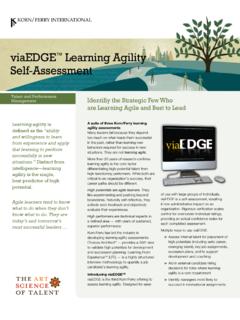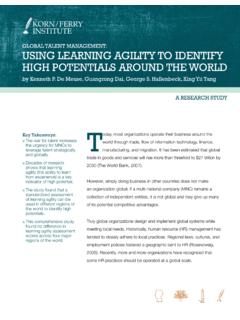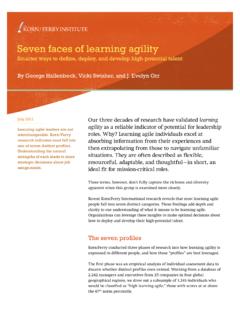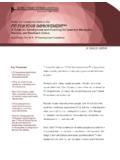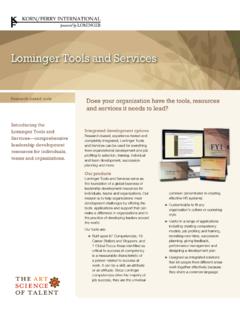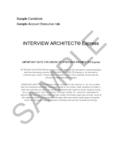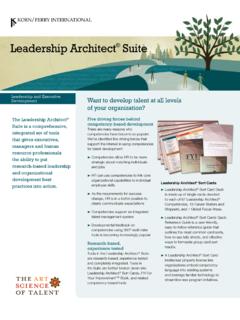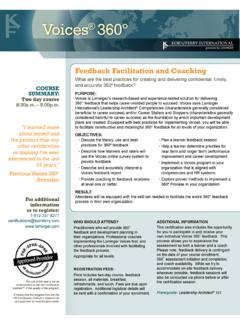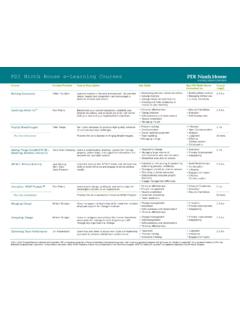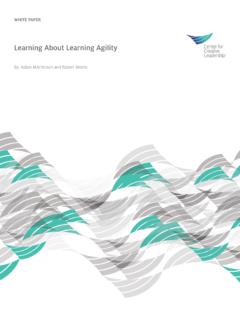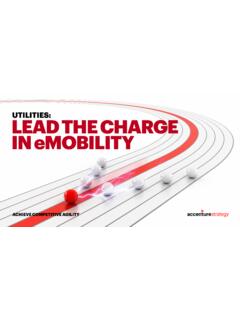Transcription of Seven faces of learning agility - kornferry.com
1 Seven faces of learning agility Smarter ways to define, deploy, and develop high-potential talent By George Hallenbeck, Vicki Swisher, and J. Evelyn Orr July 2011 Our three decades of research have validated learning learning agile leaders are not agility as a reliable indicator of potential for leadership interchangeable. Korn/Ferry roles. Why? learning agile individuals excel at research indicates most fall into absorbing information from their experiences and one of Seven distinct profiles. Understanding the natural then extrapolating from those to navigate unfamiliar strengths of each leads to more situations.
2 They are often described as flexible, strategic decisions about job resourceful, adaptable, and thoughtful in short, an assignments. ideal fit for mission-critical roles. Those terms, however, don't fully capture the richness and diversity apparent when this group is examined more closely. Recent Korn/Ferry International research reveals that most learning agile people fall into Seven distinct categories. These findings add depth and clarity to our understanding of what it means to be learning agile. Organizations can leverage these insights to make optimal decisions about how to deploy and develop their high-potential talent.
3 The Seven profiles Korn/Ferry conducted three phases of research into how learning agility is expressed in different people, and how those profiles are best leveraged. The first phase was an empirical analysis of individual assessment data to discern whether distinct profiles even existed. Working from a database of 2,242 managers and executives from 25 companies in four global geographical regions, we drew out a subsample of 1,245 individuals who would be classified as high learning agile, those with scores at or above the 67th norm percentile.
4 That subsample was then analyzed looking at scores on the four factors of learning agility : Mental agility , People agility , Change agility , and Results agility . Any strong deviations from the norm were flagged and then the data set was re-examined to see if patterns started to emerge from these deviations. learning agility : Knowing what to do when you don't In the end we found that Seven distinct profiles described approximately know what to do two-thirds of the high learning agility people. learning agility is the ability and willingness to learn from experience and then apply that Much like personality types, no profile is better or worse than the others.
5 learning to perform successfully in new Each has its own combination of strengths and developmental needs. Below situations. is a brief summary of the Seven profiles. (Extended descriptions are People who are learning agile: provided in Lominger's High learning agility Profiles tool.). > Seek out experiences to learn from. Problem Solvers: Given an ambiguous problem, they explore its > Enjoy complex problems and challenges complexities, develop a notion of what will work, and then set about associated with new experiences.
6 Resolving the situation with a mix of drive and resourcefulness. Along the way, they seek to involve others and leverage their abilities. This is > Get more out of those experiences the most frequently occurring of the Seven profiles and most closely because they have an interest in making sense of them. fits the classic definition of a high learning agile person. > Perform better because they incorporate Thought Leaders: Determined seekers of insight and truth, they ask new skills into their repertoire. hard questions and strive to make difficult connections.
7 They are A person who is learning agile has more committed to seeing progress; however, they tend to function best lessons, more tools, and more solutions to behind the scenes versus being out-front champions for change. draw on when faced with new business challenges. Trailblazers: They have a clear sense of where they need to be and are determined to make it there, sometimes by whatever means are available. Laser-focused and confident in their approach, Trailblazers are at home where others fear to tread. Champions: Like the hero in a classic tale, individuals fitting this profile have a flair for saving the day in grand style.
8 They can handle difficult situations with humor and grace. By focusing primarily on people and results, they also allow others an opportunity to shine. Pillars: Pillars put considerable effort into crafting and implementing highly refined solutions, but tend to focus more on creating an improvement than making a dramatic change. They lead with a harmonious blend of insightful thinking, focused action, and an open, inclusive manner. Diplomats: When the stakes are high and the situation calls for smooth people skills, these are the individuals you want to be at the forefront.
9 They are deft at sizing up others and can adjust their style to fit the moment. 2. Energizers: Achievement-oriented, extremely hardworking, and able to inspire others, Energizers establish larger-than-life, almost iconic reputations. Energizers put together a committed and capable team and always get the job done. Further testing of the profiles in companies outside our original research sample reinforced our findings. In some organizations, 75 percent or more of high learning agile people can be classified into one of these Seven profiles.
10 Getting to know the profiles face-to-face The next research phase consisted of in-depth interviews with individuals in senior-level roles at a major global retailer to see each profile in action. After being matched to a specific profile using Choices , a validated Source of the profiles assessment of learning agility (see sidebar), executives were asked about a wide range of topics including situations where they felt they had applied The Seven learning agility profiles were derived from data gathered using the their strengths well and situations where they had struggled or learned Choices assessment, which measures lessons the hard way.
